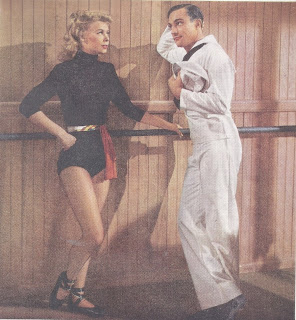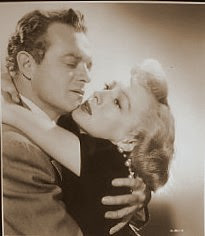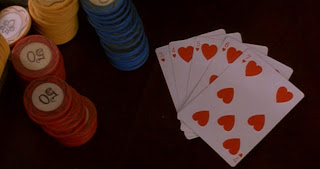
"Broadway song-and-dance man Gene Kelly made his screen debut opposite Judy Garland in MGM’s 'For Me and My Gal' (1942), which shared 'Yankee Doodle'’s black-and-white nostalgia for the previous war’s era. It was a huge hit, establishing Garland as an adult star and setting up Kelly as a threat to Astaire.

MGM didn’t seize the moment, dumping Kelly into a supporting role in the inane 'DuBarry Was a Lady' (opposite Lucille Ball) and a starring role in the lumpy 'Thousands Cheer', plus a few low-budget war dramas.

"Rita Hayworth had become a star in 1941 on loan to Warners for 'The Strawberry Blonde' and to Fox for 'Blood and Sand', then back home to Columbia for 'You’ll Never Get Rich' opposite Astaire. In 1942, she starred in Fox’s 'My Gal Sal', a Technicolor period musical in the Betty Grable mold, and was then reteamed with Astaire for 'You Were Never Lovelier', a pleasing, modest musical with divine Jerome Kern-Johnny Mercer tunes.
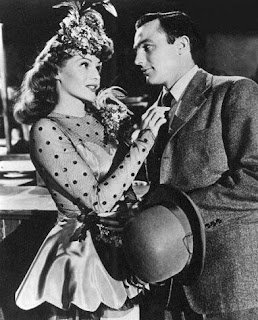
As with Kelly, it was time for Hayworth to get a vehicle that maximized her potential and raised her position to the superstar level. It came for Kelly and Hayworth in the same package: Columbia’s 'Cover Girl' (Kelly was borrowed from MGM).

Leslie Brooks, Eve Arden, Gene Kelly and Rita Hayworth in "Cover Girl" (1944) directed by Charles Vidor
With this picture, the forties musical seemed to have found a forward-looking identity. In its freshness, 'Cover Girl' also sowed the seeds for the sublime exuberance of the genre’s best works of the 1950s. Its impact would be felt throughout Kelly’s career, and it is easy to spot its influence on specific works of his. It must be said that much about 'Cover Girl' is conventional, even for 1944: the turn-of-the-century flashbacks, the backstage showbiz tribulations, the love-conquers-all notions.
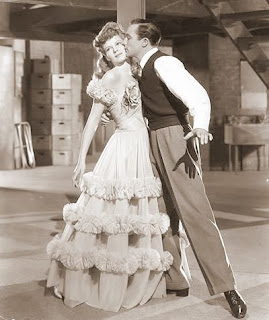
Yet, it is what’s new about it that dominates: Kelly’s virile dancing; Hayworth’s emergence as a screen goddess; a terrific Jerome Kern-Ira Gershwin score; the stylized use of color; and the razzle-dazzle camerawork and editing.

Rusty Parker (Rita Hayworth), a beautiful redheaded dancer with ambition, is a chorine at a lowbrow Brooklyn nightclub run by Danny McGuire (Gene Kelly), a war veteran returned home after being wounded in Libya. Danny also performs in the club’s revue (his wounds have obviously healed beautifully), and he and Rusty happen to be in love.

Their situation is upset when Vanity magazine chooses Rusty to be their “Golden Wedding Girl.” She becomes a celebrity, even lures the elite to Brooklyn to see her dance, and is soon being wooed professionally (and personally) by Broadway producer Noel Wheaton (Lee Bowman). Will Danny fight to keep Rusty, or will he refuse to stand in the way of her glittering future? Rusty is torn between Danny and everything she has dreamed of attaining.

Refreshingly, the movie does not turn into one of those career-or-marriage struggles so prevalent in forties films. Rusty will have to choose between two men, represented by two New York boroughs, but there is never any discussion about her not performing.

The movie has not worked so hard to put her over as a dancing goddess only to make her a housewife at the end. 'Cover Girl'’s screenplay was written by a woman, Virginia Van Upp. However, there is still plenty of old-style Hollywood moralizing: it is better to do things the hard way than to grab the easy, quick ride to fame; money and luxuries will not make you happy (and may even make you unhappy); Manhattan represents the sins of material excess whereas Brooklyn represents the values of decent, hardworking people. To be fair, the Manhattan and Brooklyn portrayed here are fantasy places —states of mind— from which Rusty must choose.

The first showstopper is “Make Way for Tomorrow” (with lyrics by E. Y. Harburg), begun by Kelly, Hayworth, and Phil Silvers late at night at a Brooklyn oyster bar, site of their weekly pearl-hunting ritual. Kelly and his assistant, Stanley Donen (also on loan from MGM), obviously remembered this number when constructing Singin’ in the Rain’s “Good Morning,” another opportunity for two men and a woman to unleash their positive energy. Kelly’s classic 'Singin’ in the Rain' solo was also influenced by “Make Way for Tomorrow” in the way he reacts to a nighttime street and those he encounters (including a cop) on it. Even garbagecan lids would be back when Kelly danced with Dan Dailey and Michael Kidd in 'It’s Always Fair Weather' (1955), the final Kelly-Donen musical.

After Rusty becomes a media sensation (but before Broadway beckons), she and Danny put a snazzy new number into the club’s revue. “Put Me to the Test” is the first sexy duet of Kelly’s career, and Hayworth’s too. (I love her numbers with Astaire in 'You Were Never Lovelier', but their dynamic does not have the amatory friskiness she shared with Kelly.) It is set in a dress shop, with Kelly as an employee (with a feather duster) and Hayworth one of the store’s six models. As they jump, glide, and embrace, the number is a celebration of their freedom, their beauty, their possibilities. It is unlike the Fred and Ginger dances; libido is explicit rather than subtextual. “Put Me to the Test” is more akin to the numbers that Kelly, and even Astaire, would do with Cyd Charisse and Vera-Ellen in upcoming musicals.

'Cover Girl' does have one sequence that is more in the classic spirit of Fred and Ginger, set to the gorgeous ballad “Long Ago and Far Away.” After-hours at the club, Hayworth, wearing an off-the-shoulder pale-blue gown with three rows of ruffles on its skirt, sings (dubbed by Martha Mears) to Kelly, in the film’s most awkward burst-into-song transition. The brief, lilting dance that results is lushly romantic, more as a worship service for Hayworth’s beauty than as memorable choreography, but the song is so good that it hardly matters what they do.

'Cover Girl' is probably best remembered as the film that contains Kelly’s first real innovation as a movie-musical artist. With Stanley Donen, he devised the “Alter Ego” dance, a rather sophisticated nervous breakdown. Danny is torn between giving up on Rusty or fighting for her. A second Danny, transparent as a ghost, appears to him in a store window and speaks to him. The alter ego thinks Danny should let Rusty go, but Danny can’t accept that. Dressed identically (in a plain suit and a bow tie), they dance their power struggle, with the alter ego trying to manipulate and control Danny, who is sometimes weak and malleable, sometimes combative.

That’s the psychological drama being waged, the fight within Danny himself. Kelly’s intensity and the darkness of the concept make for a thrilling sequence. It is the downer version of his “Singin’ in the Rain” street romp.

If the disparate forces at work here (the Kelly-Donen influx from MGM, the Columbia-backed push for Hayworth’s superstardom, the wartime ambiance, the time-worn flashbacks, the spectacle of the color design) seem to be at cross-purposes, it hardly matters since it is all in the name of putting on a humdinger of a show. At the directing helm was Charles Vidor, an underrated figure of the studio system, who made several fine films noted for their striking visual sense. He was particularly good with color, making his palette a crucial part of the dramatic content in films like 'Love Me or Leave Me' (1955) and 'The Swan' (1956).

The hypnotic world of artifice created by the entire crew hovers near kitsch but transcends it. It is a film in which a receptionist has a pink phone, a grand staircase seems never to end, a cabbie costume (Hayworth’s) sports a mini-skirt. 'Cover Girl' received Oscar nominations for color cinematography, color art direction, sound, and song (“Long Ago and Far Away”). It won the Oscar for “scoring of a musical,” beating MGM’s 'Meet Me in St. Louis', which was released at the tail end of 1944.

'Cover Girl' may not be artistically or dramatically as accomplished as 'Meet Me in St. Louis', but it paved the way for the kind of vigor that Kelly and Donen would bring to the New York locations of 'On the Town' (1949). With the Kelly-Donen influence on such exhilarating display, Columbia’s 'Cover Girl' is figuratively the first important MGM musical of the 1940s. Kelly then made 'Anchors Aweigh' (1945), beginning his glorious decade of actual MGM musical successes. He would reteam with Phil Silvers on MGM’s 'Summer Stock' (1950).

It is easy to dismiss 'Cover Girl' as manufactured, silly, and overproduced, yet it is a knockout of Hollywood craftsmanship, and the invention and zest that went into it should not be disregarded". -"Cover Girl: Gene Kelly, Rita Hayworth and the breed of new musical" essay by John DiLeo (2011).
 Cyd Charisse and Gene Kelly in "Singin' in the Rain" - "Broadway Rhythm Ballet" (1952) directed by Stanley Donen & Gene Kelly
Cyd Charisse and Gene Kelly in "Singin' in the Rain" - "Broadway Rhythm Ballet" (1952) directed by Stanley Donen & Gene Kelly








































